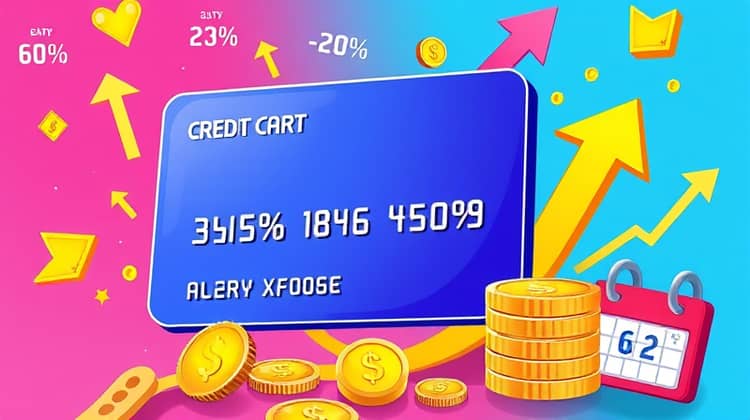Credit Card Interest Rates: How to Fully Understand and Minimize Fees

Credit cards can provide great convenience in managing your finances, but understanding their interest rates is essential for maximizing benefits and minimizing costs. Knowing how interest rates work and what influences them can empower you in your financial planning.
- What are credit card interest rates?
- Why do credit card companies charge interest?
- How can interest rates affect your payments?
Understanding credit card interest rates is crucial for anyone who uses credit cards regularly. These rates can significantly impact your financial health, especially if you carry a balance. Being informed helps you to make better decisions and manage your debts effectively.
Understanding Credit Card Interest Rates

The interest rate on a credit card is the cost of borrowing money, expressed as a percentage. It is crucial to understand that this rate can vary widely from one card to another, and even change based on your behavior and payment history. In this section, we will break down what these rates mean and how you can navigate them effectively.
A significant component of credit card interest rates is the Annual Percentage Rate (APR), but different types of APRs can also apply, adding complexity to the equation. Understanding these aspects will help you become a more informed credit card user.
1. Annual Percentage Rate (APR)
The Annual Percentage Rate (APR) represents the yearly interest rate charged on borrowed money. It includes not just the interest costs but also any fees involved in securing the loan. This rate is critical because it allows consumers to understand how much borrowing on a credit card will cost in the long term.
Typically, credit card companies advertise APRs prominently, and maintaining a low APR can save you significant money over time. If you only pay the minimum payment, the APR will heavily influence how much interest accrues on your balance.
2. Different Types of APR
Credit cards can have multiple APRs that apply to different transactions, which is why it’s essential to know the specifics of your card’s terms and conditions. Some common types of APR include standard APR, introductory APR, and penalty APR.
- Standard APR: The usual interest rate applied to your purchases after the introductory period ends.
- Introductory APR: A temporarily low rate offered on purchases made within a set time frame after account opening.
- Penalty APR: A higher rate applied if you miss payments or exceed your credit limit.
Understanding these different types of APRs can help you avoid unnecessary fees and plan for the total cost of your credit usage. It's wise to carefully read the terms when you receive a new credit card offer to spot any unfavorable APRs that could impact your finances.
3. How Interest is Calculated
Credit card interest is typically calculated using a method called average daily balance, which involves looking at your balance each day and calculating the interest owed based on the daily periodic rate. This means that unpaid balances accrue interest day by day.
Moreover, most credit cards reset the balance every billing cycle, making it crucial for cardholders to manage their payments so as to avoid accumulating excessive interest.
Factors Affecting Credit Card Interest Rates

Several factors can influence the interest rates on credit cards. Knowing these factors can better prepare you to manage your card effectively and negotiation opportunities with lenders. One primary determinant is your credit score; the healthier your credit, the lower your potential interest rate.
Additionally, the type of credit card, promotional offers, and the overall economic environment can significantly impact the interest rate assigned to your account. Credit card issuers evaluate risk when determining the APR they will extend to you.
- Credit score and credit history
- Type of card (secured vs. unsecured)
- Promotional offers and special rates
- Inflation and economic conditions
Understanding these factors is essential for consumers because it sheds light on why your credit card interest rates might differ from another person's, even if it appears you're using the same card.
How to Minimize Credit Card Interest

Minimizing credit card interest is a smart financial decision that can save you a considerable amount of money in the long run. Here are several strategies to consider.
1. Pay Your Balance in Full
One of the simplest ways to avoid credit card interest is to pay your balance in full each month. By doing this, you avoid the interest charges that typically accrue when a balance is carried over into the next billing cycle. This can save you hundreds of dollars annually, especially if your credit card has a high interest rate.
2. Look for Low-Interest Cards
When searching for credit cards, don't just settle for the first option that comes along. Take the time to compare various interest rates across different cards and look for ones that provide lower rates, especially for balance transfers or cash advances. Switching to a card with lower interest can provide immediate savings, as well as create longer-term benefits for your overall financial picture.
Additionally, many credit cards offer promotional low-interest rates as an introductory offer. These can provide a great way to manage and repay existing debts without accumulating extra interest, helping you pay down balances more quickly.
3. Transfer Balances to Lower Rates
Balance transfers are an efficient way to consolidate debt under a lower interest rate. If you currently have high-interest debt on one card, moving that balance to a new card with a lower APR can save you money and help you pay off your debt faster.
- Research cards that offer low or 0% introductory balance transfer rates.
- Calculate any transfer fees to determine if the transfer will truly save you money.
- Create a payment plan to ensure you can pay off the balance before the introductory period ends.
This tactic can be highly effective if carefully planned and executed; however, ensure you understand the terms involved and avoid incurring high fees.
4. Be Wary of Cash Advances
Cash advances carry extremely high interest rates and often come with additional fees. Unlike purchases, interest on cash advances typically starts accruing immediately, with no grace period to avoid interest charges. It's best to avoid cash advances when possible, as they can rapidly increase your debt and may lead to financial strain.
5. Negotiate for Lower Rates
If you have a good payment history and your credit score has improved since you first obtained your card, consider calling your credit card issuer to negotiate a lower interest rate. Being proactive can yield significant savings and demonstrates that you are a responsible borrower who values good terms.
Conclusion

Understanding credit card interest rates is essential for financial well-being. By being mindful of how rates are calculated and what factors influence them, you can make better decisions concerning your credit card usage.
Implementing strategies to minimize interest rates and associated fees can lead to substantial savings and greater control over your finances. With informed choices, you can effectively manage credit and build a solid financial future.






